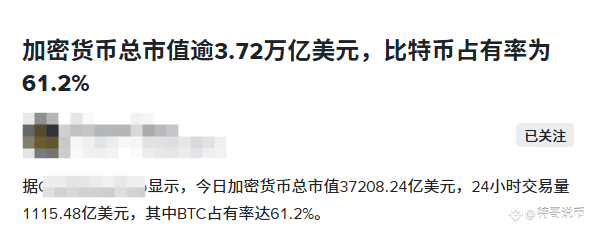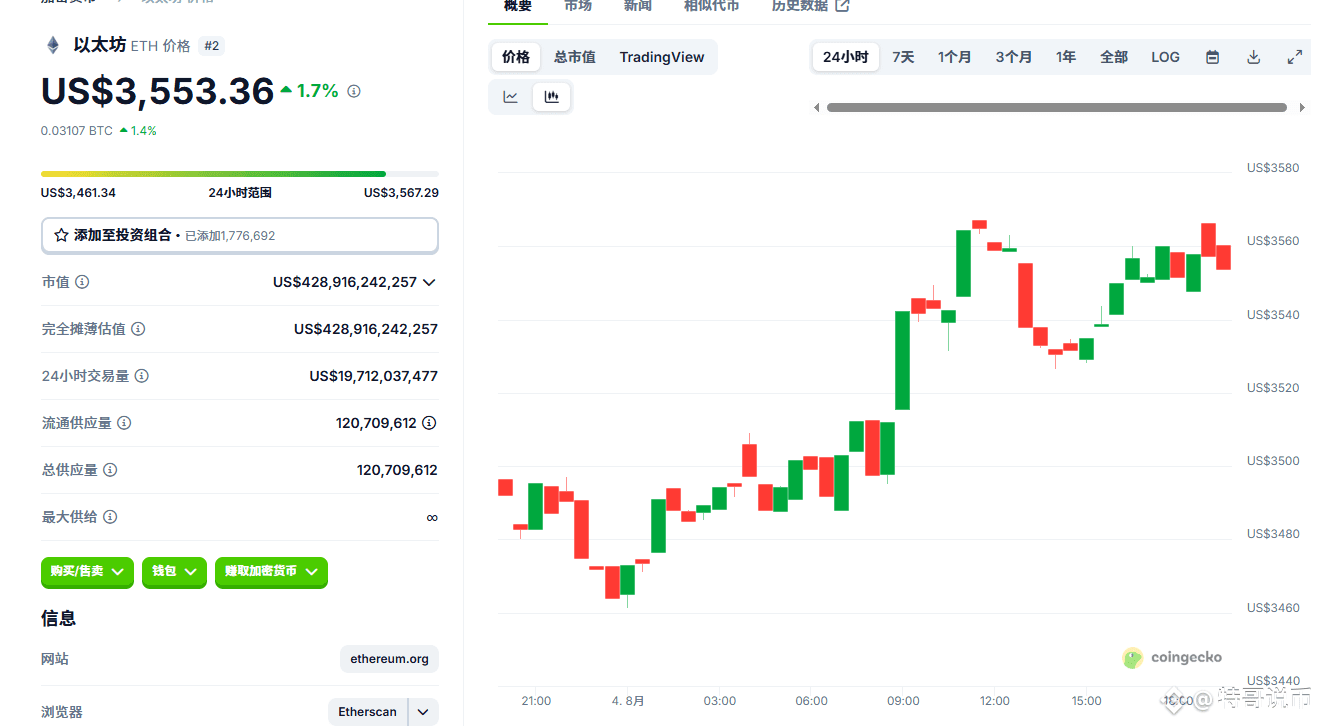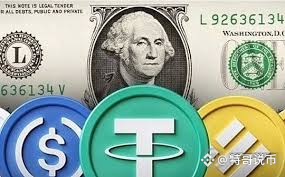Bitcoin's market share skyrockets to 61.2%! The pattern of 'one dominance and many strengths' in the crypto market is set; how can retail investors catch this wealth train?
The most explosive news in the crypto circle recently is that Bitcoin's market share has officially surpassed 61.2%, setting a new historical high since 2021! This is not just a simple number game; it means that the crypto market has officially entered the 'Bitcoin hegemony era.' From institutional funds pouring in to global regulatory loosening, from ETF explosions to the rise of stablecoins, the underlying logic of this wealth feast is undergoing dramatic changes. Today, let's talk plainly about what opportunities are hidden in this wave of market movements.

One, why can Bitcoin be 'the only one'?
First, let's look at some heart-wrenching data: By 2025, the total market value of cryptocurrencies is expected to exceed $38.7 trillion, but outside the top 10 cryptocurrencies, altcoins only hold 12.3% market share! In other words, the current market is dominated by 'Bitcoin eating meat, Ethereum drinking soup, and other coins gnawing on bones.'
Why can Bitcoin be so fierce?
Institutions vote with their feet: MicroStrategy, Tesla, and other listed companies are hoarding Bitcoin as 'digital gold,' with 228 listed companies globally holding over 820,000 BTC, a market value far exceeding their net assets.
ETFs become money printing machines: The US Bitcoin ETF scale has surpassed $1.1 trillion, with Wall Street giants like BlackRock and Fidelity frantically attracting capital, earning a fortune just from management fees.
Regulatory endorsement: The US (GENIUS Act) requires stablecoins to have 100% cash reserves, and the EU MiCA Act mandates exchanges to conduct KYC, making Bitcoin, as the 'compliance leader,' the biggest beneficiary.
For example, a mining giant, Marathon Digital, directly announced 'only hoarding, not selling,' and even issued $2 billion in convertible bonds to aggressively increase holdings. This is not mining; it's clearly 'mining gold mines'!

Two, why have Ethereum and others 'fallen behind'?
Don't be fooled by Ethereum's current market share of 11.9%; in 2021, it once held 47.6%! Why is it now falling further behind Bitcoin?
DeFi Bubble Burst: The bubble created by 'liquidity mining' in the past two years has burst; now the locked value of top DeFi protocols is only $82 billion, less than one-third of its peak.
Layer 2 Competition: New public chains like Solana and Avalanche have transaction fees as low as a few cents, challenging Ethereum's status as the 'noble chain.'
Regulatory Hammer: The rumors that the SEC classifies ETH as a 'security' have never ceased, and large institutions are hesitant to heavily invest.
But don't be too quick to write off Ethereum; it is brewing a big move—staking yield reform + RWA. For example, BlackRock plans to put government bonds and real estate on-chain, and in the future, ETH might transform from 'gas fees' to 'yield certificates,' and this transformation is worth looking forward to.

Three, stablecoins: The 'invisible king' of the crypto market.
Don't just focus on Bitcoin; stablecoins are the real 'quietly making a fortune'! By 2025, the market value of stablecoins will exceed $250 billion, with an annual trading volume of more than $35 trillion, even more than the sum of Visa + MasterCard!
Why is it so fierce?
Cross-border payment revolution: In inflationary countries like Argentina and Venezuela, USDT accounts for 68% of crypto trading volume, and some even use Bitcoin to pay rent.
Traditional finance enters the market: JPMorgan, Citibank are preparing stablecoins, and JD.com even claims it will cut cross-border payment costs by 90% using stablecoins.
Compliance frenzy: The EU MiCA Act requires stablecoin issuers to keep 30% of their reserves in banks, while Singapore directly requires exchanges to have a registered capital of no less than 250,000 SGD; small workshops are being eliminated, and top platforms' market share has soared to 60%.

Four, how should retail investors play now?
Bitcoin: Hold long-term, refuse leverage.
Currently, Bitcoin is like 'digital gold,' but don't imitate those gamblers trading contracts—when Trump's tariff policy came out on August 1, over $60 million was liquidated within 24 hours; how many people went to zero overnight? Remember: Buy with spare money, store it in a cold wallet, and forget the password.
Ethereum: Focus on RWA and staking.
Once BlackRock puts government bonds on-chain, ETH could become 'on-chain US Treasury,' and at that time, staking yields might be even more attractive than bank wealth management. But don’t rush to chase high prices; wait for a pullback before getting in.
Stablecoins: Earn interest spreads + arbitrage.
Buy USDT on compliant exchanges, store it on platforms like BlockFi to earn 8% annualized yield, while keeping an eye on exchange rate differences—like when the Argentine peso plummets, use USDT to bottom-fish local assets for guaranteed profits.
Beware of 'altcoin traps.'
Currently, 90% of altcoins in the market are 'air'; don't be fooled by the talk of 'hundredfold coins' and 'thousandfold coins.' If you really want to bet on high returns, it’s better to wait until the Bitcoin ecosystem explodes and then look for those small coins with real use cases.
Five, let me say something very straightforward.
The crypto market now resembles the internet of 2000—Bitcoin is Tencent, Ethereum is Alibaba, stablecoins are Alipay, and other coins? Most of them are '.com bubbles.' Ordinary people shouldn't think about bottom fishing or top escaping; instead, focus on Bitcoin + stablecoins + compliant platforms as the three main lines for long-term holding, which is the right way.
Tego's Viewpoint: In a bull market, money is made from trends; in a bear market, money is made from knowledge. The fact that Bitcoin's market share has surpassed 61.2% is the clearest trend signal!
Tego shares daily insights; the team behind only serves ambitious maniacs, directly feeding you the secrets to tenfold coins.